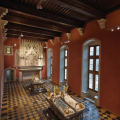Visit a completely transformed museum!
The Dijon Museum of Fine Arts is located in the center of the city, in the former ducal palace. It is one of the oldest museums in France. It was founded in 1787 and its initial ambition was to exhibit works of art that would allow students of drawing schools to use them as models. Throughout its long history, it has undergone various variations and has recently been completely restructured. The mayor of Dijon, Minister of Culture Franck Riester, and the president of the Regional Council, Marie-Guite Dufay, cut the ribbon on May 17, 2019, ending a fifteen-year construction project. François Hollande, Laurent Fabius and Frédéric Mitterrand were also present. A larger exhibition space is now available to the public, allowing the presentation of 1,500 works. The permanent exhibition has been completely redesigned. Chronological and thematic, it allows visitors to stroll through fifty rooms tracing eight periods of history from Antiquity to the 20th century, with a dialogue between paintings, sculptures, art objects, furniture, etc. In addition, as far as possible, the periods of the collections coincide with those of the buildings in which they are displayed. It should be noted that new tools are available to assist visitors, such as room texts, labels, multimedia tables and Nomade (a multimedia guide provided by the museum). The building is finally accessible to all publics. The renovation work lasted 15 years, supported by the City, and was designed and implemented by the architectural team of Yves Lion (project manager) and Éric Pallot, chief architect of historical monuments. An agreement was also signed with the Louvre Museum, opening the door to future collaborations. The collections of the Dijon Museum of Fine Arts are very rich. In total, 130,000 works are conserved, from Antiquity to the contemporary period. The medieval collections are the most important in terms of quality and quantity. Among the treasures of the museum are the tombs of the Dukes of Burgundy. These are presented in the great hall of the palace and are among the most impressive funerary monuments of the late Middle Ages. The tombs of Philip the Bold and of John the Fearless and Margaret of Bavaria come from the Charterhouse of Champmol, a former monastery of the Carthusian order in Dijon. They were exceptionally restored after the Revolution and were placed in the great hall of the Ducal Palace in 1827. They are one of the must-see attractions in Dijon. Impressive and majestic, the architecture of these tombs is marked by the statues of the alabaster mourners that support them. Sculpted with great finesse, these forty-one religious and secular figures bear witness to all the stages of mourning. If the heritage of the Dukes of Burgundy is important in the medieval exhibition, one should not underestimate the importance of other works such as those of the Italians Taddeo Gaddi and Pietro Lorenzetti or the Flemish artists Le Maître de Flémalle and Albrecht Bouts. The Musée des Beaux-Arts in Dijon also houses an important Egyptian collection of nearly 1,000 pieces, about 100 of which are on display. These works come mainly from legacies made by the Dijon archaeologist Albert Gayet. There are many testimonies of the funeral rituals of ancient Egypt such as the sarcophagus of Ankfef or funeral masks. From one room to another, we will then travel to the masterpieces of European painting, from the Renaissance to the 19th century. The Italian Renaissance is particularly well represented at the Musée des Beaux-Arts in Dijon with paintings by Giorgio Vasari, Titian and Veronese. The 17th century collections include works by Guido Reni and Pierre-Paul Rubens. The originality of the 18th century collections lies in the productions of the Dijon School of Drawing. Particularly active during this period, it was the only art school outside Paris to organize its "Prix de Rome". The 19th century collections follow, from which works by renowned artists such as Rodin, Delacroix, Manet and Pissarro stand out. The spaces reserved for the 20th century honor Burgundian sculpture - François Pompom and Henri Bouchard - and the important donations made by Kathleen and Pierre Granville. The Musée des Beaux-Arts de Dijon is also open to contemporary production by organizing various exhibitions or artists' residencies, including works by Yan Pei Ming. In addition to these different collections classified chronologically, the museum also offers a graphic arts cabinet composed of 12,500 drawings and 60,000 prints, produced from the late Middle Ages to the contemporary period. In addition, following the renovation of the museum, part of the non-European collections is now on display. We can see for example ivories from Africa, Japanese porcelain or Indian sculptures. The Musée des Beaux-Arts de Dijon, with its important collection and its recent restructuring, is a must-see in the city.
Did you know? This review was written by our professional authors.
The strengths of this establishment:
Book the Best Activities with Get Your Guide
Members' reviews on MUSÉE DES BEAUX-ARTS DE DIJON
The ratings and reviews below reflect the subjective opinions of members and not the opinion of The Little Witty.
Find unique Stay Offers with our Partners












Il propose un parcours chronologique et thématique.
C'est un musée incontournable pour les amateurs d'art et d'histoire, offrant une expérience inoubliable à ses visiteurs.
Situé au cœur de Dijon, il est facilement accessible et mérite une visite approfondie.